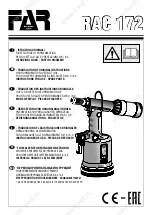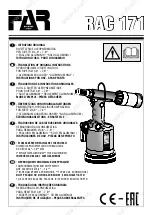
Rev. 8
1–1
CHAPTER 1 - GENERAL
INTRODUCTION
PURPOSE
The purpose of this manual is to provide guidance to RV-12 owners, pilots,
mechanics, regulatory officials, and aircraft/component manufacturers that are certified
to perform maintenance, repairs, and alterations on the light sport aircraft covered in
this manual.
SUMMARY
This manual contains maintenance instructions for the RV-12 light sport aircraft.
The RV-12 is a single engine, fixed tricycle gear, full-cantilever monoplane. The two-
seat cockpit is enclosed with a tip-up windscreen/canopy. The occupants sit side-by-
side, aft of the engine and forward of the wing spar. Both of the wings are quick
removable. The flaperons remain with the wings and self-connect to the control linkage
when the wings are installed. The empennage consists of a vertical stabilizer, rudder
and stabilator with anti-servo/trim tab.
The airframe is a semi-monocoque aluminum structure, with some steel and
fiberglass parts. Fiberglass composite parts are used to finish some non-structural
portions of the aircraft.
The pilot and passenger board the aircraft from either side using the boarding
step and a reinforced area near the leading edge of the wing. The pilot is seated on the
left side (from within the cockpit) of the aircraft. A combination Electronic Flight
Information System (EFIS) and Engine monitoring System (EMS) with graphical user
interface is used to monitor and report flight and engine performance information to the
pilot.
The Rotax 912ULS 100 hp four cylinder engine is enclosed in a fiberglass
composite cowling at the front of the aircraft. Engine power is transferred via an integral
gearbox to the Sensenich composite propeller.
The pilot and the passenger both have full flight and ground controls. Pitch and
roll is controlled from either control stick. The control sticks are linked by push/pull rods
and torque tubes to the flaperons, and linked by cables to a stabilator. The flap lever
controls the flap function of the flaperons. Yaw is controlled using rudder pedals linked
by cables to a traditional rudder that is hinged to a fixed vertical stabilizer. The rudder
pedals have integrated left and right foot pedals that are used to independently control
the wheel brake on the corresponding side.
Summary of Contents for RV-12
Page 30: ...Rev 8 THIS PAGE INTENTIONALLY LEFT BLANK 1 22...
Page 54: ...Rev 5 3 18 THIS PAGE INTENTIONALLY LEFT BLANK...
Page 86: ...Rev 6 5 30 THIS PAGE INTENTIONALLY LEFT BLANK...
Page 96: ...Rev 4 6 10 THIS PAGE INTENTIONALLY LEFT BLANK...
Page 128: ...Rev 1 10 6 THIS PAGE INTENTIONALLY LEFT BLANK...
Page 152: ...Rev 5 12 20 THIS PAGE INTENTIONALLY LEFT BLANK...
Page 172: ...Rev 1 15 6 THIS PAGE INTENTIONALLY LEFT BLANK...
Page 178: ...Rev 4 17 4...
Page 179: ...Rev 4 17 5 THIS PAGE INTENTIONALLY LEFT BLANK...
Page 181: ...Rev 8 18 2 THIS PAGE INTENTIONALLY LEFT BLANK...
Page 183: ...Rev 8 18 4 THIS PAGE INTENTIONALLY LEFT BLANK...
Page 185: ...Rev 8 18 6 THIS PAGE INTENTIONALLY LEFT BLANK...
Page 187: ...Rev 8 18 8 THIS PAGE INTENTIONALLY LEFT BLANK...
Page 189: ...Rev 8 18 10 THIS PAGE INTENTIONALLY LEFT BLANK...
Page 191: ...Rev 8 18 12 THIS PAGE INTENTIONALLY LEFT BLANK...
Page 193: ...Rev 8 18 14 THIS PAGE INTENTIONALLY LEFT BLANK...
Page 195: ...Rev 8 18 16 THIS PAGE INTENTIONALLY LEFT BLANK...
Page 197: ...Rev 8 18 18 THIS PAGE INTENTIONALLY LEFT BLANK...
Page 199: ...Rev 8 18 20 THIS PAGE INTENTIONALLY LEFT BLANK...
Page 201: ...Rev 8 18 22 THIS PAGE INTENTIONALLY LEFT BLANK...
Page 203: ...Rev 8 18 24 THIS PAGE INTENTIONALLY LEFT BLANK...
Page 204: ...Rev 8 18 25 3 VIEW...
Page 205: ...Rev 8 18 26 THIS PAGE INTENTIONALLY LEFT BLANK...
Page 207: ...Rev 8 18 28 THIS PAGE INTENTIONALLY LEFT BLANK...
Page 211: ...Rev 3 19 4 THIS PAGE INTENTIONALLY LEFT BLANK...










































